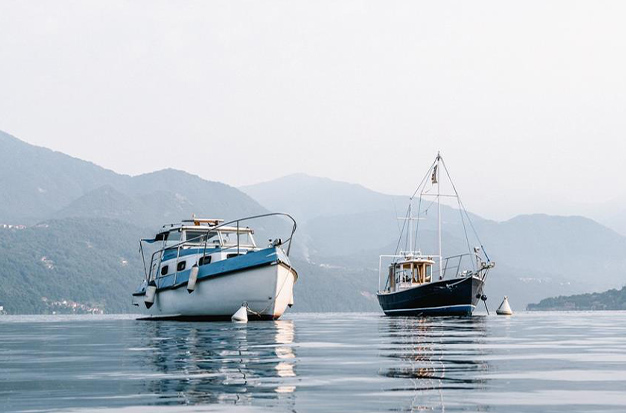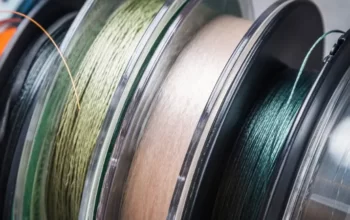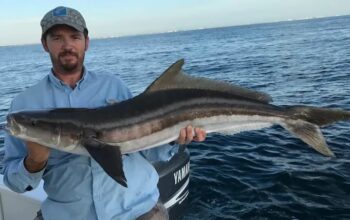Learning how to pass fishing boats is one of the most crucial boating skills to develop. So how should a fishing boat be passed?
To safely pass a fishing boat, you should steer your boat to the starboard side or the right side of the boat. Or, to put it another way, the two boats ought to be passing one another on their port sides, or left sides.
You ought to slow down your boat as you pass the fishing vessel. This is significant, particularly if your boat is noticeably bigger or smaller than the other boat in size. It’s just common courtesy to prevent the smaller vessel from being thrown by a big wake.
Continue reading to find out more about passing a fishing boat, including how to do it correctly, the laws that apply, and why doing it correctly is crucial.
Table of Contents
Importance Of Correctly Passing A Fishing Boat
Accident risk is always increased because there are so many recreational boats registered in the US. Therefore, even though boating is a wonderful way to spend time on the water, you should be aware that passing a fishing boat is subject to certain rules.
Everyone who operates a boat should abide by the general rule to give other boats plenty of room in the water and avoid crossing over their wakes. In situations where there are nearby fishing boats, it is more crucial to abide by this fundamental rule.
You are expected to act in this manner, just as you would in a traffic situation. Without understanding the rules of the road, you cannot operate a vehicle on public roads. A road accident is guaranteed to occur if the rules of the road are not followed. You are putting not only other drivers’ lives in danger but also your own.
The same holds true for the waterways in the US, as well as all other nations on earth. You can’t simply choose for yourself where you want to go and what you want to do with your boat on the water.
Federal laws thus regulate and govern the use of all types of boats whenever they are navigating bodies of water in the United States in order to prevent accidents and the loss of lives. Regulations on how to pass a fishing boat are part of these federal laws.
How Do You Pass A Fishing Boat?
The short answer is simple if you’re wondering how you should pass a fishing boat. The laws of the water require all boaters to take precautions to prevent collisions. Power vessels must give way to fishing boats with gear in the water according to the hierarchy of the so-called right-of-way.
Rules Of The Water
According to the most recent 2017 statistics, almost 50 million Americans went fishing. Despite the fact that more than half of fish are caught from the shore, proper boater education is crucial to avoiding accidents involving fishing boats.
There isn’t a clearly defined right-of-way like there is when you’re driving, which is how boating differs from driving. As an alternative, you must abide by best practices or the law. Depending on whether you’re in international or inland waters, there are different rules. Rivers and the Great Lakes are subject to specific legal restrictions as well. It is your duty as the boat’s captain to be familiar with them.
Pecking Order
Depending on how much control each pilot has over their boat, there is a hierarchy that governs navigation. On the bottom of the totem pole is an powered boat that is moving. They are then followed in the following order, from lowest to highest priority:
- Sailboats
- Fishing boats actively engaged
- Vessels with navigation restricted by draft
- Boats with limited maneuverability due to gear in the water such as nets
- Unmanned vessels
- Boats being overtaken by another
Therefore, it appears that fishing boats clearly have the right-of-way over powered vessels. Those who are trolling are the exception to this rule. If so, they must follow the same rules as the latter to prevent either boater from having to start looking up new boat prices.
Navigation Rules
Defining some terms is necessary before talking about how to pass a fishing boat. The hull is the main part of the ship. The bow is at the top, and port is on the left. Starboard is to your right. Sternness is in the back.
The give-way boat and the stand-on boat are the two boats that approach each other. In order to avoid a collision and to let the other boater know that he intends to stop or change course, the former yields to the latter. The latter is the one who is actively catching up to the other. In order to prevent an accident, this person must also warn the other of his actions and take similar safety measures.
Crossing A Fishing Boat
Keep in mind that when they aren’t fishing, boaters are just like any other powered boat on the water. If the two cross paths, there are specific guidelines for passing each other. Understanding how the boat is constructed will be useful in this situation.
If the fishing boat is on your port side, you are the stand-on boat and he is the give-away boat. Observe the navigational guidelines that were previously listed. The stand-on vessel has an unobstructed view, which is the reason for the distinction. Both avoiding an accident and skipping the boat payment calculator are easier to do.
Special Situations
Additionally, there are navigational rules that apply to other circumstances where it might be necessary to understand how to pass a fishing boat. The first is night, which makes navigation easier because waters with speed limits have lower ones then. Additionally, it might be simpler with lights on the ship.
Meeting Head-on With A Fishing Boat
Each boat passing on the port side is the preferred maneuver in this scenario. You must both maintain a safe distance between you and exercise caution. It’s crucial to maintain a safe speed while passing one another, and you should even consider slowing down if necessary, particularly if the two personal watercraft differ significantly in size.
Usually, the freeboard of fishing boats is lower. The distance between the gunwale, or upper edge, of the hull, and the water’s surface, is that. A boat passing quickly will leave a sizable wake in its wake and may spray water into the other. It is good boater etiquette rather than a written regulation.
Night Boating
The boat has two colored front lights. Always read is the one on the left. You can keep that in mind by remembering that the port has the same color and four letters as the side’s name. Always green is the right one or the starboard one. Additionally, a white elevated light will be visible on the stern or back of the ship. You can tell where it’s going and which way it’s facing by using this information.
Sailboats
Due to the maneuverability limitations, sailing vessels are given the right of way. People in positions of authority are the exception. They frequently have used outboard motors to assist them in docking their boats and navigating into ports.
Tight Quarters
You must navigate to the right, much like a road, if you encounter a fishing boat in a congested channel. If you can’t pass side-by-side because the width is too narrow, let larger vessels pass. No matter how the fish are biting, it’s typically forbidden for a fishing boat to anchor in a channel.
Other Rules For Passing A Fishing Boat
Numerous other laws are just common sense. The right-of-way belongs to a fishing boat that is anchored. Keep enough space between you and them. They could be far from their vessel along a line. A line wrapped around your boat’s propeller is the last thing either of you wants.
Additionally, it honors the water’s use by all. Their enjoyment and safety are compromised by creating a big wake or buzzing the fishing boat. Nearly 4,300 boating accidents occurred in 2017, says the US Coast Guard. More than 15% involved fishing boats.
Having fun on the water and getting back to nature are made possible by boating and fishing. Whether you’re casting a line from the shore or anchored in your preferred location, it’s critical to practice proper safety. Keep in mind that boaters should always be considerate of one another, particularly when it comes to navigation and the law of the water.

Steps For Passing A Fishing Boat
When passing a fishing boat, the aforementioned procedures must be strictly adhered to. Here are the steps you can take to pass a fishing boat safely keeping these guidelines in mind:
Reduce Speed
The skipper of the passing vessel should slow down as it approaches the fishing vessel. The captain can maneuver the boat to maintain a sufficiently safe distance from the fishing boat by slowing down. This will guarantee that the ship won’t run into the fishing boat.
Wait For The “all-clear” Signal
This action serves as a safety precaution as well as a courtesy to the other boater. The approaching boat must wait until the “give way” boat signals that it is safe to pass. Boaters frequently use their horns to signal or communicate with one another.
Pass On Port
It is customary to pass on the left when passing a car carrying a person. It is the same when you are passing a fishing boat. You should always try to pass on the port side of the ship, which is on the left, according to the US Coast Guard. In order for both vessels to pass each other on their port sides, you must steer toward starboard. You must give one honk when you’re prepared to pass this way. They’ll give you a single honk in response when they’re prepared for you to pass.
This isn’t always an option, though. It’s possible that you won’t be able to pass the fishing boat on that side if their lines are cast in that direction from their port side. You assume the role of the “stand-on” when this occurs. They must receive a signal before you pass them on their starboard side, and you must then wait for the all-clear. By twice honking your horn, you can indicate that you are passing on the starboard side. You can pass after they honk twice in response.
Pass Slowly
Slowly passing a fishing boat is the final safety measure. Attempt to avoid leaving wakes by passing very slowly. Any fishing boat that creates a significant wake faces serious risks. Many fishing gears and boat passengers may be thrown overboard if a passing boat creates a significant wake.
Conclusion
You must direct your boat to the other boat’s right or starboard side in order to pass that boat safely. This means that both your boat and the other boat should pass on their port sides or left-hand sites.
The captains of the fishing boat and the passing boat should follow certain procedures. To avoid having their vessels collide with one another, they must adhere to these protocols.




